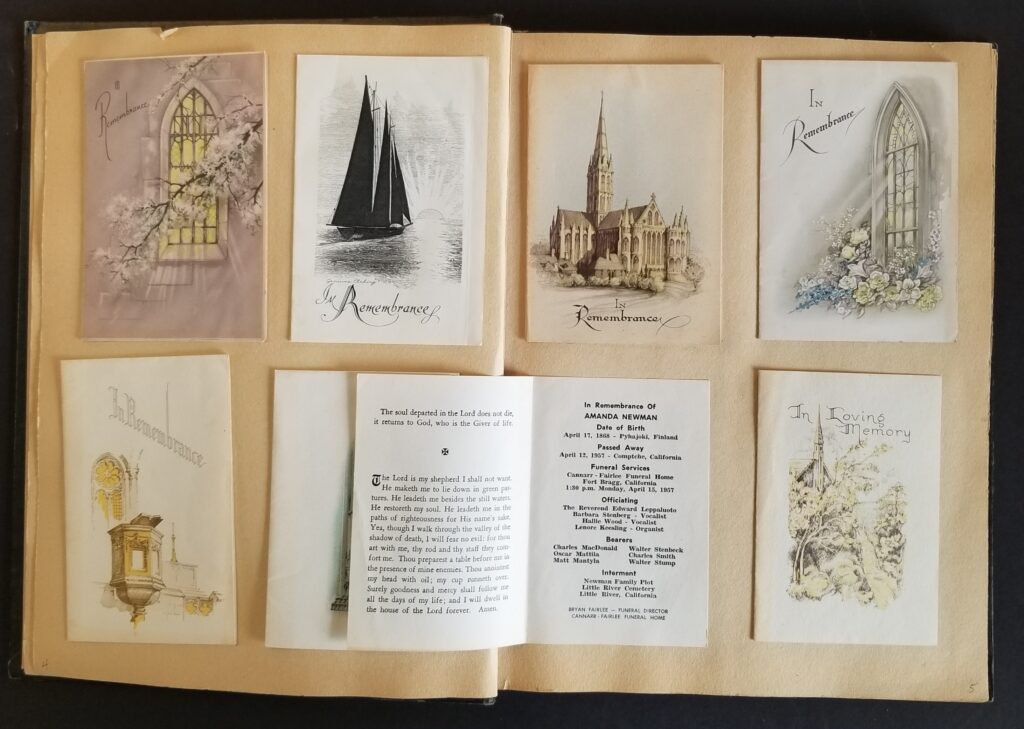So, I walk into the Comptche Store and owner Belinda Pollack hands me a sheet of paper with a list of names and says, ”Look what someone gave me! And who was Amanda Newman?” Another local history exploration begins.
Belinda and my husband are both multi-generational descendants of old-time Comptche families, so we knew the names on the list. It was titled, “Comptche Friends Floral Tribute to the Memory of Mrs. Amanda Newman,” but there was no date. Of the forty-four people who contributed 50 cents or one dollar, only two are still alive – Jimmy Ciro and Buddy Stenback. Belinda’s grandmother was on the list, so we knew the list had to have been made before 1959, the year Grandma Wilma Shandel died.
Research at the Kelley House using past Mendocino Beacon issues took me to the April 1957 obituary for Amanda Newman, who resided at Keene Summit. She was 88 when she passed and had lived in Comptche 60 years. Born in 1868 in Pyhajoki, Finland, she was the mother of 12 children, eight of whom survived into adulthood.
The sign-up sheet for the flowers reflected the Finnish heritage of Comptche, with Mattilas and Tahjas, and Juintillas and Hannulas, and Mantylas and Stenbacks. It was a community tradition when somebody died for the storekeepers to collect a bit of money from everyone for a floral tribute at the funeral ceremonies. Bob and Edith Enochs were the store owners back then.
Comptche never had a formal graveyard or cemetery, so Amanda was buried in the Newman plot at the Little River Cemetery. Her daughter Miriam went on to live 103 years. The obituary said that Amanda’s funeral services were arranged through the Cannarr-Fairlee Funeral Home in Fort Bragg, so that started me thinking about funeral cards.

The Kelley House archives has an unusual scrapbook that contains 80 small funeral cards, including those of many Comptche elders. It was donated to us by local resident Sandra Hawthorn, but we have no idea who compiled it. The cards span more than 30 years, and sure enough, I checked and Amanda Newman’s funeral card was there, on page 5.
I would guess many people have found these funeral cards in their family possessions. Meant to be a meaningful keepsake, they tell us the dates and places of birth and death. Often the person’s lifespan was also listed in years, months, and days. The officiating member of the religious community was included, with the names of the organist, the vocalist, the pallbearers, and the honorary bearers. If the deceased was a veteran, his area of service was listed. The date and place of the funeral ceremony and the interment were also mentioned, along with the funeral home providing their services.
In the Museum’s album, some funeral cards are fancier than others, depending on the options the bereaved family selected from those offered by the funeral home. Different qualities of paper, and varied motifs and artwork could be selected for the front. Inside, the deceased’s photo could be included, and families might choose a bible verse or song lyric to remind them of their loved one. For veterans, there seemed to be a standard military design.
The Kelley House has indexed the funeral cards and added the information to the Family Files in the archives. Did you know the Museum has files on hundreds of local families dating back to the 1860s? Contact Karen McGrath if you think your family might be included. curator@kelleyhousemuseum.org.